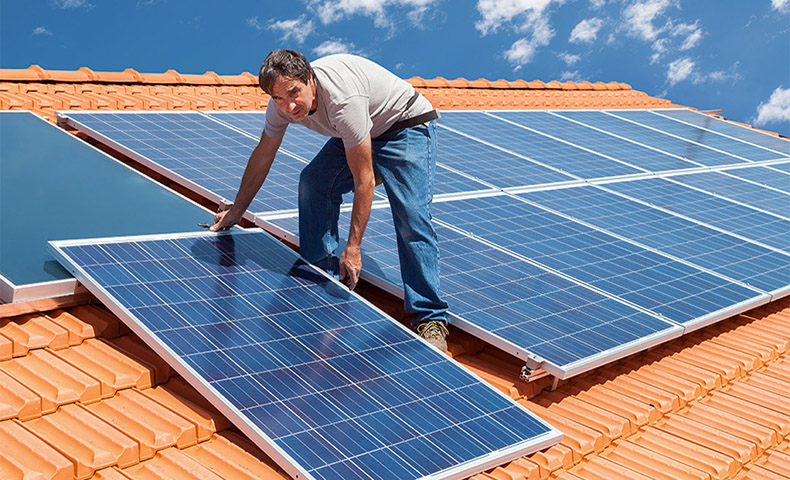
When you discuss your energy needs with a solar installer and the contractor recommends a certain layout for the solar panels, how many are needed, and the size of inverter necessary to produce that electricity, you’re probably expecting to hit that goal every single day.
But the reality is that solar production changes daily, sometimes more, sometimes less, depending on a number of factors, such as weather and climate.
Lab vs real-life conditions
A solar panel wattage will determine the amount of power it produces. But this peak wattage refers to the amount of DC power the photovoltaic (PV) modules generate under test conditions.
At the lab, researchers hit the panels with 1000 Megajoules of solar radiation per square meter while the cell temperature of the solar panel is 77 degrees Fahrenheit.
These ideal conditions don’t occur that often in the real world. You can’t expect your solar panels to generate the maximum amount listed on their labels most days.
Season and weather
Remember also that a lot depends on how much sunshine and how long in a day the panels are receiving that sunshine.
In the winter daylight time is shorter and, thus, you will have less energy production as opposed to the summer, when days are longer and there’s more abundant sun.
The sun is also lower in the sky during wither, which means the sun rays will be heating the solar panels less directly than during the summer months.
Also, you’ll naturally have more cloud cover during the winter, which can impact energy production, notes the Renewable Energy Transition Initiative.
Gary Elmer, who has used solar in the past, notes in an online message board that “solar panel ratings are peak power. So ratings are based on a new freshly cleaned solar panel at the perfect angle to an unobstructed sun. Also if the panel put out 975 Watts it would be marketed as a 1K panel (sic). Some manufacturers I am sure would round up a 951 Watt panel to 1000Watts.”
He explains you must subtract efficiency from a non-perfect angle if your panel does not track with the sun, and “subtract a bit of loss due to dust on the panels or haze or dust in the air, losses due to clouds and/or shadows cast on the panels.”
“But it gets worse, battery charging losses and inverter inefficiencies further limit the total amount of electrical energy than can be practically pulled from the panel(s),” he adds.
Elmer notes that the only way around these losses is to “overspec” your supply of panels so that on average you will get the actual power out that you need.
If you don’t know what the correct size of your solar power system should be, you can easily find out with the Hahasmart price checker. Just provide your address and your average monthly utility bill and you’ll get the actual price of solar panels and inverters - which are the most critical parts of a solar powered system - as well as provide you with an estimated cost of installation based on thousands of completed solar projects in your area.
They’ll even provide you with an estimated buyback period, the point where the electricity savings achieved with your solar array cover the purchase of your residential solar panels and your system becomes free.
In addition, they’ll connect you with their installer network to get your residence equipped with solar power as possible.
Solar panel degradation
Something else that plays a role in energy production is solar panel degradation.
According to LG, there is Potential Induced Degradation (PID), a phenomenon where odium enrichment occurs between the chemicals used on the surface of the solar cell and the glass in certain circumstances, causing a leakage of current between the cells and the solar panel frame. The intensity of the degradation depends on the module type, the ambient environmental conditions and the position of the solar panel in the array string. A high system voltage (eg 600V +) and high ambient humidity can lead to a film of moisture on the solar panel surface. A drift of positive ions occurs from the glass towards the solar cell in the opposite direction, which is believed to cause degradation in the solar cell. Tests by the German Fraunhofer Institute showed that solar panels which are susceptible can lose more than 30% of their rated power through this effect and as much as 90% in extreme cases.
LG explains that there is also Light Induced Degradation (LID). All solar cells degrade when they are first exposed to sunlight. It is generally accepted that the effect is most pronounced if boron oxygen defects are more prevalent within the silicon structure, although it can occur on the surface layers too. The result is simply described as an increase in the density of the material which makes the movement of electrons more difficult, which results in less power flow.
In Mono Crystalline and Poly Crystalline solar panels, the effect is more subtle (in the order of around 0.7% power loss per annum). Over the years, the panels become slightly less efficient and will over time produce slightly less electricity. Over 25 years it is around 20%.
HahaSmart Blog - More Solar Tips and Guide
HahaSmart News - Stay Informed
Your Solar Incentives - See Credits and Incentives in Your Area
Check Your Home's Solar Price - See How Much You Save
Register Now - Unlock The Lowest Solar Prices in Your Area


Input your address to see if it is solar friendly and how much you can save with solar.
Great. Your address is perfect for solar. Solar incentive is still available. Select monthly utility cost and calculate the size of solar system you will need now.
| kw System size | years Payback period | Lifetime savings |
No money down, 100% finance is available.
|
|
Sign up to understand more about solar panel costs, see quote right away |
Comments